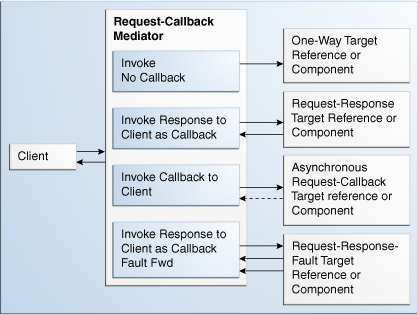Request-Callback Message Exchange Patterns
In a request-callback interaction, the Mediator is invoked and may send an asynchronous reply to the caller. Depending on the type of routing rule target, the responses, faults, and callbacks are handled as shown in Table 24-5:
Table 24-5 Response When Mediator's WSDL Is a Request Callback
| WSDL of the Routing Rule Target | Response |
|---|---|
|
Request |
There should be at least one sequential routing rule with a request-callback service. No callback is sent to the caller if there is no routing rule with a defined callback. |
|
Request Response |
The response is sent back to the caller, as a callback, in a separate thread. You can create additional routing rules to forward the response to another target or event. |
|
Request Response Fault |
The response is sent back to the caller, as a callback, in a separate thread. The fault is forwarded to another target or event. As above, you can create additional routing rules to forward the response to another target or event. |
|
Request Callback |
The callback is sent back to the caller. |
|
Request Response Callback |
The callback is sent back to the caller, and the response is forwarded to another target or event. |
|
Request Response Fault Callback |
The callback is sent back to the caller. The response and fault are forwarded to another target or event. |
Figure 24-4 illustrates the request-callback message exchange pattern.
Figure 24-4 Request-Callback Message Exchange Pattern

Description of "Figure 24-4 Request-Callback Message Exchange Pattern"